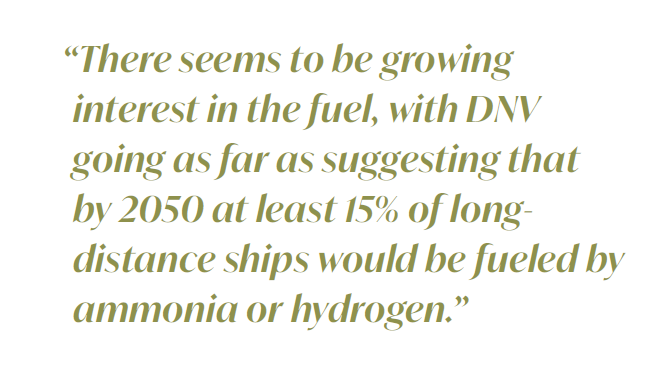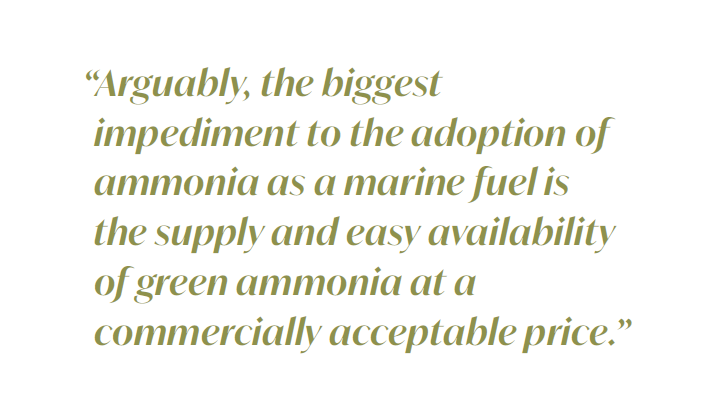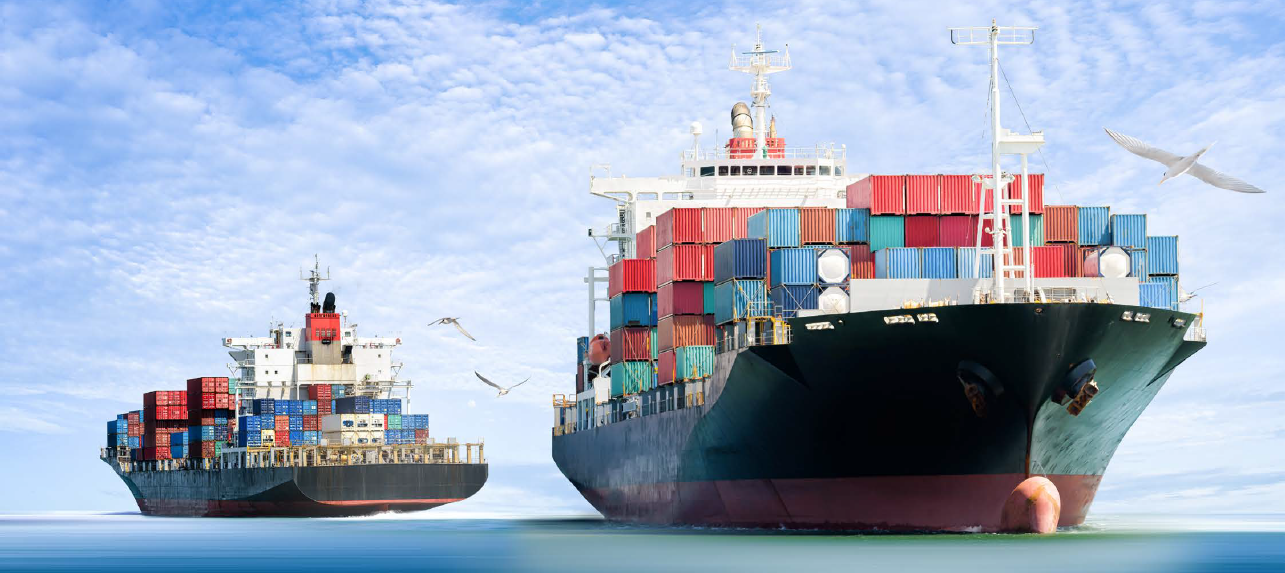The tricky road to reaching ammonia's full potential [Gas in Transition]
Better the devil you know, as the saying goes, might be an appropriate analogy for the use of ammonia as a marine fuel.
The easily available but toxic gas has many things going for it, including a long history of being produced and supplied globally, mainly for agricultural and industrial uses.
However, while the Global Maritime Forum, among others, increasingly sees ammonia as having a key role to play as a zero-carbon fuel, the gas's advantage – no carbon emissions during combustion – is also its Achilles heel. The problem is ensuring this characteristic is retained during the production process, is able to be reliably certified and can be scaled up quickly enough to meet demand.
The keyword here being "green ammonia" – when the gas is produced using renewable energy or other zero-carbon methods, and results in no carbon being emitted on a well-to-wake basis.
According to Bureau Veritas, ammonia is among the top contenders as a fuel of the future. As a commonly transported cargo, ammonia use and handling is familiar to many marine actors while it benefits from existing production and storage terminals at many ports around the world. Thus developing associated ship-to-ship and ship-to-shore bunkering infrastructure will be relatively straightforward.
ABS meanwhile says that "ammonia is identified as a zero-carbon fuel that can enter the global market relatively quickly and help meet the greenhouse gas reduction target for 2050 set by the IMO.”
On ammonia, DNV says: "We think that there are significant but not insurmountable technical and safety challenges associated with ammonia as a marine fuel."
The class society adds that "barriers to adoption relate to the source of ammonia and the future cost of green ammonia", noting that most of the currently produced ammonia has hydrocarbon origins and thus no carbon reduction advantages.
DNV points out that in contrast, green ammonia is an excellent source of zero-carbon fuel, provided that associated NOx emissions are managed appropriately.
But even non-green ammonia has inherent advantages, prime among which is the fact that it does not emit CO2 during combustion, making it zero-carbon from the outset, at least on a tank-to-wake basis.
Pros and cons
Some of ammonia's characteristics also stand in its favour, with an energy density similar to methanol and better than hydrogen. Ammonia is also liquefied at higher temperatures and lower pressures than hydrogen and enjoys a significant storage cost advantage over hydrogen. It has about half the energy density of bunker fuels however.
In terms of production, ammonia benefits from relatively lower costs. The well-established Haber-Bosch process that produces ammonia from renewable hydrogen is efficient and fully scaled and requires less energy than the synthesis of methanol or e-methane.
On the flipside however, green ammonia still remains more expensive than incumbent fuels, although prices are expected to fall as green hydrogen production ramps up.
Among the biggest stumbling blocks are safety and the accompanying need for adequate regulation. As a highly toxic, flammable and corrosive substance that poses risks for humans and aquatic life,strict safety standards, measures, and training are needed in line with its wide adoption as a marine fuel.
Regulatory collaboration
While discussions are ongoing, the imminent adoption of ammonia in the shipping industry needs regulatory collaboration to be expedited, especially between international bodies and local regulators.
The current International Code for the Construction and Equipment of Ships Carrying Liquefied Gases in Bulk (IGC Code) mainly covers the transport of the gas while the International Code of Safety for Ship Using Gases or Other Low-flashpoint Fuels (IGF Code) was designed mainly to address issues arising from the usage of the gas or low-flashpoint liquids as fuel, but does not address toxicity problems with fuels such as ammonia. The large scale production, bunkering and use of ammonia to power ships still lacks universal standards and regulation however, an urgent prerequisite, considering its dangers.
Standards are also needed to ensure and certify the sustainable, zero-carbon production of ammonia in the first place. Current production of ammonia is a highly carbon-intensive process and essentially indistinguishable in the final product from zero-carbon production. Being able to distinguish and appropriately price green ammonia is critical to its successful use as a zero-carbon shipping fuel.
Growing interest
Nonetheless, there seems to be growing interest in the fuel, with DNV going as far as suggesting that by 2050 at least 15% of long-distance ships would be fueled by ammonia or hydrogen.
 Meanwhile as at March 2021, the Global Maritime Forum's second edition of its Mapping of Zero Emission Pilots and Demonstration Projects found that "the most significant trend we are seeing with newer large ship technology projects is the post-2020 increase in the uptake of large ammonia vessels". And while more recent numbers are encouraging, it should be noted that this pre-dates the sudden sharp rise in methanol-powered ship orders in 2022.
Meanwhile as at March 2021, the Global Maritime Forum's second edition of its Mapping of Zero Emission Pilots and Demonstration Projects found that "the most significant trend we are seeing with newer large ship technology projects is the post-2020 increase in the uptake of large ammonia vessels". And while more recent numbers are encouraging, it should be noted that this pre-dates the sudden sharp rise in methanol-powered ship orders in 2022.
Two years ago, there was already a fairly impressive list of projects comprising mainly concept but also a few actual newbuild projects covering the full gamut of ship types from product tankers to very large crude carriers and various sizes of container ships and bulk carriers and even an ammonia-fuelled tug boat.
A range of green ammonia production and supply chain and bunkering projects was also listed, including Vopak Singapore's agreement with Japan's Itochu to explore the development of an independent, onshore facility for the storage and handling of ammonia with loading/ unloading functions in the world's top bunkering port.
Notably, most of the shipbuilding and design projects originate from the Asian yards featuring traditional heavyweights such as South Korea, Japan and China.
Among the Japanese, top shipping line NYK and power company JERA stand out as key players in the ammonia space, with the former pushing a range of ship designs and concepts, including a gas carrier and floating storage and regasification barge and a tug and the latter investing strongly in various projects around the world.
Smaller player K Line meanwhile has announced ammonia will underpin its decarbonisation strategy to 2050, with AiP granted for a new Newcastlemax bulk carrier design. The third major Japanese line MOL is also active, with a recently announced Capesize design and also a cooperation agreement on renewable ammonia supply chain with Japanese and Thai partners.
Not to be left behind, the Koreans have announced in 2023 an agreement between Hyundai Heavy Industries, Lloyd’s Register and Korea National Oil Corporation to jointly develop an ammonia floating storage and regasification unit as well.
European projects such as the NoGAPS project tend to be more broadly focused, comprising companies from across the shipping and ammonia value chain, in efforts to develop a holistic proof of concept and roadmap for the construction of the world’s first ammonia powered deep sea vessel.
Back then also, Greece's Avin International in 2021 featured as the first shipowner to place an order for an ammonia-fuel ready vessel – a Suezmax tanker ordered at China's New Times Shipbuilding.
Production projects meanwhile included the collaboration between Yara and Engie to convert part of the production at its Pilbara plant's production in Australia to renewable energy as well as do the same at its Porsgrunn facility in Norway.
Progress has been quick, with a steady stream of projects being announced. As at the beginning of 2023, Grimaldi Group had announced firm orders and options for up 17 ammonia-ready car carriers.
Ammonia's characteristics mean that it lends itself to certain applications better than others in the shipping industry. For example, its affinity to liquefied petroleum gas means that a popular application has been in dual-fuel very large gas carriers, where Japanese shipowners have already achieved success in chartering out such ships ahead of delivery in 2025.
More critically, a collaboration between engine maker WinGD and shipping firm CMB is working on the key missing piece of the puzzle - engines that have actually been proven to be able to use ammonia. Most engine makers have set 2024 as the deadline for them to hit the market, but this remains a target for now.
This project will see ammonia dual-fuel engines actually being deployed in a series of 10 Capesize bulkers being built in China and due for delivery in 2025.
Ammonia's toxicity also sees it tending to be used in deep sea vessels, which have relatively lower contact with human populations than other ship types.
Meanwhile rapid progress is being made on the supply chain side. National level imperatives in countries such as India and Japan for example are ensuring that infrastructure is being rapidly put in place with 2025 commonly being set as the deadline.
In South Korea's Ulsan port, the first of two ammonia shipments have arrived from Saudi Arabia, with importer Lotte Fine Chemical leading the development of a clean ammonia supply chain in the Yellow Sea.
Among innovative production projects, Dutch company SwitcH2 and BW Offshore's Floating Production Storage and Offloading (FPSO) concept to produce 600 tons of renewable ammonia a day has secured Approval in Principle (AiP) from DNV.
Global ports player Louis Dreyfus Ports and Logistics has meanwhile developed a mobile terminal concept capable of storing and supplying hydrogen as renewable ammonia. The concept won AIP status from the Korean Register in 2022.
Dubbed the Floating Renewable Energy Solution for Hydrogen (FRESH), the vessel will transport ammonia from production points to regions lacking import infrastructure such as deep water jetties, on-shore crackers, and dedicated import and storage terminals.
Japanese companies are also investing in green ammonia production overseas, with Mitsui & Co leading the development of Chile's HyEX project, which will use solar to produce 18,000 metric tons/year of renewable ammonia.
Japan's JERA has also been actively securing green ammonia supply, signing up to 1mn mt/yr offtake agreements with two US Gulf Coast producers.
While the US, especially on the Gulf Coast, is ramping up exports (which could potentially prove highly competitive if Biden-era tax breaks are applied) various production and bunkering projects in key European ports mean the continent will also be well served.
Outlook
Citing IEA figures, Grigorii Soloveichik, a consultant who spoke at an Ammonia Energy Association briefing, said the demand for ammonia will increase to 460m metric tonnes per year by 2050 from 185m metric tonnes currently. And if ammonia does end up being used as the predominant maritime fuel it will triple the current production.
Out of this, the market size for clean ammonia, currently small at $63mn, is expected to grow over 70% annually to $5.5bn.
There is clearly good potential for the development and increasing use of ammonia as a zero-carbon fuel for the shipping industry. While there are challenges to its adoption, these are well known and there are strong incentives to overcome them.
Arguably, the biggest impediment to the adoption of ammonia as a marine fuel is the supply and easy availability of green ammonia at a commercially acceptable price.
After all, the main reason for using the gas is its zero-carbon combustion properties. If this is negated by carbon emissions at other stages in the production or supply cycle, all these efforts would have come to nought.
The ammonia industry is reacting quickly to meet these challenges, boosted by investments from those with an interest in decarbonising, while the supply chain is also being upgraded to meet the new demands that supplying the shipping industry will place on it. Whether all the chips fall into place in time remains to be seen.




